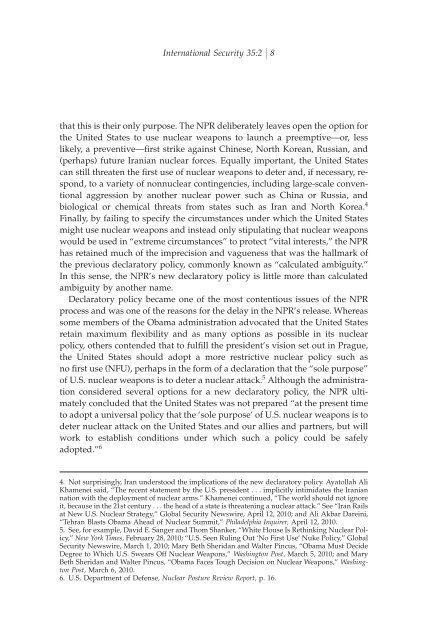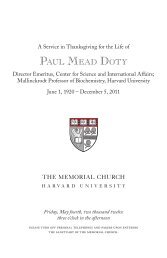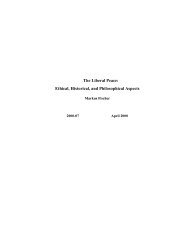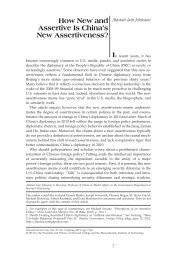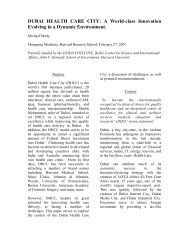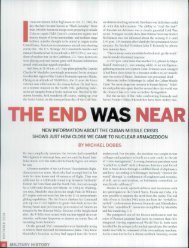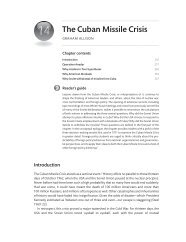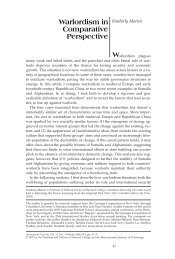The Next Step for U.S. Nuclear Policy - Project MUSE
The Next Step for U.S. Nuclear Policy - Project MUSE
The Next Step for U.S. Nuclear Policy - Project MUSE
You also want an ePaper? Increase the reach of your titles
YUMPU automatically turns print PDFs into web optimized ePapers that Google loves.
International Security 35:2 8<br />
that this is their only purpose. <strong>The</strong> NPR deliberately leaves open the option <strong>for</strong><br />
the United States to use nuclear weapons to launch a preemptive—or, less<br />
likely, a preventive—ªrst strike against Chinese, North Korean, Russian, and<br />
(perhaps) future Iranian nuclear <strong>for</strong>ces. Equally important, the United States<br />
can still threaten the ªrst use of nuclear weapons to deter and, if necessary, respond,<br />
to a variety of nonnuclear contingencies, including large-scale conventional<br />
aggression by another nuclear power such as China or Russia, and<br />
biological or chemical threats from states such as Iran and North Korea. 4<br />
Finally, by failing to specify the circumstances under which the United States<br />
might use nuclear weapons and instead only stipulating that nuclear weapons<br />
would be used in “extreme circumstances” to protect “vital interests,” the NPR<br />
has retained much of the imprecision and vagueness that was the hallmark of<br />
the previous declaratory policy, commonly known as “calculated ambiguity.”<br />
In this sense, the NPR’s new declaratory policy is little more than calculated<br />
ambiguity by another name.<br />
Declaratory policy became one of the most contentious issues of the NPR<br />
process and was one of the reasons <strong>for</strong> the delay in the NPR’s release. Whereas<br />
some members of the Obama administration advocated that the United States<br />
retain maximum ºexibility and as many options as possible in its nuclear<br />
policy, others contended that to fulªll the president’s vision set out in Prague,<br />
the United States should adopt a more restrictive nuclear policy such as<br />
no ªrst use (NFU), perhaps in the <strong>for</strong>m of a declaration that the “sole purpose”<br />
of U.S. nuclear weapons is to deter a nuclear attack. 5 Although the administration<br />
considered several options <strong>for</strong> a new declaratory policy, the NPR ultimately<br />
concluded that the United States was not prepared “at the present time<br />
to adopt a universal policy that the ‘sole purpose’ of U.S. nuclear weapons is to<br />
deter nuclear attack on the United States and our allies and partners, but will<br />
work to establish conditions under which such a policy could be safely<br />
adopted.” 6<br />
4. Not surprisingly, Iran understood the implications of the new declaratory policy. Ayatollah Ali<br />
Khamenei said, “<strong>The</strong> recent statement by the U.S. president . . . implicitly intimidates the Iranian<br />
nation with the deployment of nuclear arms.” Khamenei continued, “<strong>The</strong> world should not ignore<br />
it, because in the 21st century . . . the head of a state is threatening a nuclear attack.” See “Iran Rails<br />
at New U.S. <strong>Nuclear</strong> Strategy,” Global Security Newswire, April 12, 2010; and Ali Akbar Dareini,<br />
“Tehran Blasts Obama Ahead of <strong>Nuclear</strong> Summit,” Philadelphia Inquirer, April 12, 2010.<br />
5. See, <strong>for</strong> example, David E. Sanger and Thom Shanker, “White House Is Rethinking <strong>Nuclear</strong> <strong>Policy</strong>,”<br />
New York Times, February 28, 2010; “U.S. Seen Ruling Out ‘No First Use’ Nuke <strong>Policy</strong>,” Global<br />
Security Newswire, March 1, 2010; Mary Beth Sheridan and Walter Pincus, “Obama Must Decide<br />
Degree to Which U.S. Swears Off <strong>Nuclear</strong> Weapons,” Washington Post, March 5, 2010; and Mary<br />
Beth Sheridan and Walter Pincus, “Obama Faces Tough Decision on <strong>Nuclear</strong> Weapons,” Washington<br />
Post, March 6, 2010.<br />
6. U.S. Department of Defense, <strong>Nuclear</strong> Posture Review Report, p. 16.


